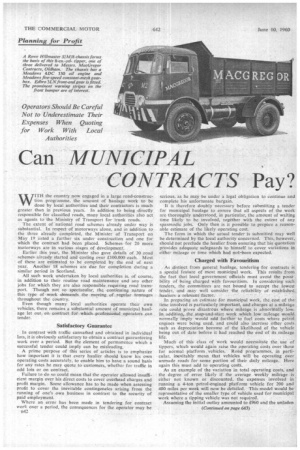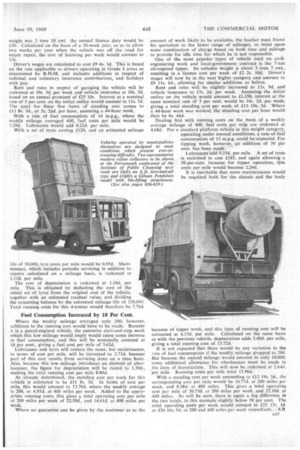Can MUNICIPAL CONTRACTS Pay?
Page 108

Page 111

If you've noticed an error in this article please click here to report it so we can fix it.
WITH the country now engaged in a large road-construction programme, the amount of haulage work to be done by local authorities and their contractors is much greater than in previous years.. In addition to being directly responsible for classified roads, many local authorities also act as agents to the Ministry of Transport for trunk roads.
The extent of national road schemes already under way is substantial. In respect of motorways alone, and in addition to the three already completed, the Minister of Transport on May 19 iisted a further six under construction and one for which the contract had been placed. Schemes • for 20 more Motorways are in various .stages of development.
Earlier this year, the Minister also gave details of 30 road schemes already started and costing over £100,000 each. Most of these are estimated. to be :completed by the end of. next year. Another 18 schemes are due for completion during a similar period in Scotland.
All such work undertaken by local authorities is, of course, in addition to their routine road maintenance and any other jobs for which they arc also responsible requiring road transport. Though not 'so spectacular, the -continuing nature of this type of work demands the moving of. regular tonnages throughout the country.
Even though many local authorities operate their own vehicles, there remains a substantial amount of municipal haulage let out. on contract for .which. professional. operators can tender.
Satisfactory Guarantee
In contrast with traffic carivafsed and obtained in individual lots, it is obviously satisfactory to obtain a contract guaranteeing work over a period. But the element of permanence which a successful tender could imply can be misleading.
A prime purpose of this series of articles is to emphasize how important it is that every haulier should know his own . operating costs accurately, to enable him to have a sound basis for any rates he may quote to customers, whether for traffic in odd lots or on contract.
Failure to do so could mean that the operator allowed insufficient margin over his direct costs to cover overhead charges and profit margin. Some allowance has to be made when assessing profit to cover the inevitable contingencies arising from the running of one's own business in contrast to the security of pa id employment.
Where an error has been made in tendering for contract work over a period, the consequences for the operator may be rA2 serious, as he may be under a legal obligation to continue and complete his unfortunate bargain.
It is therefore doubly necessary before submitting a tender for municipal haulage to ensure that all aspects of the work are thoroughly understood, iti particular, the amount of waiting time likely to be involved, tog6ther with the extent of any spasmodic jobs. Only then is it possible to prepare a reasonable estimate of the likely operating cost.
The form in which the actual tender is Submitted may well be determined by the local authority concerned. This, however, should not preclude the haulier from ensuring that his quotation provides adequate safeguards to himself to cover variations in either mileage or time which had not-been expected.
Charged with Favouritism As distinct from general haulage, tendering for contracts is a special feature of most municipal work. This results from the fact that local government officials must avoid thepossi-. bility of being charged with favouritism. In considering such. tenders, the committees arc not bound to accept the lowest tender, and may well consider the reliability of established hauliers a relevant lac tor.
In preparing an estimate for municipal work, the cost of the time involved is particularly important, and charges at a mileage rate could prove disastrous where mileage is abnormally low. In .addition, the stop-and-start work which low, mileage, would normally imply would add further to fuel costs where petrol engines were being used, and could also increase other costs such as depreciation because of the likelihood of the vehicle being out of date before it had reached the end of its mileage life'.
Much of this class of work would necessitate the use of tippers, which would again raise the operating costs over those for mirmal platform .'vehicles. Road programmes, in particular, inevitably mean that vehicles will be operating over unmade roads for some portion of their daily mileage. Here
again this must add to operating costs'. • As an example of the variation in totaloperating costs, and the degree of error likely if the average weekly mileage is either not known or discounted, the expenses 'involved in. running a 4-ton petrol-engined platform vehicle for 200 and 400 miles per week will now be detailed. This model would be representative of the smaller type of vehicle used for municipal work where a tipping vehicle was not required.
Assuming the initial outlay amounted to £960 and the unladen weight was 2 tons 10 cwt. the annual licence duty would be £30. Calculated on the basis of a 50-week year, so as to allow two weeks per year whcn the vehicle was off the road for major repair, the cost of licensing per week would amount to 12s.
Driver's wages are calculated to cost a 4s. 3d. This is based on the rate applicable to drivers operating in Grade I areas as determined by R.H.68, and includes additions in respect of national and voluntary insurance contributions, and holidays with pay.
Rent and rates in respect of garaging the vehicle will be reckoned at 10s. 3d. per week and vehicle insurance at 10s. 2d. based on an annual premium of £25 10s. Interest at a nominal rate of 3 per cent. on the initial outlay would amount to I Is, 7d. The total for these five items of standing cost comes to ill 8s. 3d., or 5s. 21d. per hour, assuming a_44-hour week.
With a rate, of fuel consumption of 14 m.p.g., where the weekly mileage averaged 400, fuel costs per mile would be 3.29d. Lubricants would add 0.22d. per mile.
With a set of tyres costing £120, and an estimated mileage life of 30,000,1yre costs per mile would be 0.95d. Maintenance, which includes periodic servicing in addition to repairs calculated on a mileage basis, is reckoned at 2.12d. per mile.
The cost of depreciation is reckoned at I.18d. per mile. This is obtained by deducting the cost of the initial set of tyres from the original cost of the vehicle, together with an estimated residual value, and dividing the remaining balance by the estimated mileage life of 150,000. Total running costs for this 4-tonner would therefore be 7.76d.
Fuel Consumption Increased by 10 Per Cent.
Where the weekly mileage averaged only 200, however, adtlitions to the running cost would have to be made. Because it is a petrol-engined vehicle, the excessive start-and-stop work which this low mileage would imply would cause some increase in fuel consumption, and this will be nominally assessed at 10 per cent., giving a fuel cost per mile of 3.62d.
Lubricants and tyres will remain the same, but maintenance, in terms of cost per mile, will be increased to 2.71d. because part of this cost results from servicing done on a time basis. Also, because this low mileage introduces an element of obsolescence, the figure for depreciation will be raised to 1.30d., making the total running cost per mile 8.80d.
As already determined, the standing cost per week for this vehicle is estimated to be £11 8s. 3d, In terms of cost per mile, this would amount to 13.70d. where the weekly average is 200, or 6.85d. at 400 miles per week. Added to the appropriate running costs, this gives a total operating cost per mile at 200 miles per week of 22.50d., and 14.61d, at 400 miles per week.
Where no guarantee can be given by the customer as to the amount of work likely to be available, the haulier must frame his quotation to the lower range of mileages, or insist upon some combination of charge based on both time and mileage to provide for idle time for which he is not responsible.
One of the most popular types of vehicle used on civilengineering work and local-government contract is the 7-ton oil-engined tipper. Its unladen weight is about 3 tons 7 cwt., resulting in a licence cost per week of £2 2s, 10d. Driver's wages will now be in the next higher category and amount to £9 I Is. 6d., allowing for similar additions as before.
Rent and rates will be slightly increased to Its. 9d.. and vehicle insurance to 17s. 2d. per week. Assuming the initial outlay on the vehicle would amount to £1,350, interest at the same nominal rate of 3 per cent. would be 16s. 2d. per week, giving a total standing cost per week of £13I9s. 5d. Where a 44-hour week was worked, the standing cost per hour would then be 6s. 4i-d.
Dealing first with running costs on the basis of a weekly average mileage of 400, fuel costs per mile are reckoned at 4.68d. For a standard platform vehicle in this weight category, operating under normal conditions, a rate of fuel consumption of 15 m.p.g. could be expected. For tipping work, however, an addition of 50 pr cent. has been made.
Lubricants'add 0.25d. per mile. A set of tyres is reckoned to cost £185, and again allowing a 50-per-cent. increase for tipper operation, tyte costs per mile would become 2.24d.
It is inevitable that more maintainance would be required both for the chassis and the body because of tipper work, and this item of running cost will he estimated at 4.15d. per mile. Calculated on the same basis as with the previous vehicle, depreciation adds 2.40d. per mile, giving a total running cost of 13.72d.
It is not expected that there would be any variation in the rate of fuel consumption if the weekly mileage dropped to 200. Bat because the annual mileage would, amount to only 10,000, some additional allowance for obsolesence must be made in the item of depreciation. This will now be reckoned at 2.64d. per mile. Running costs per mile total 13.96d.
With a standing cost per week amounting to £13 19s. 5d., the corresponding cost per mile would be 16.77d. at 200 miles per week, and 8.38d. at 400 miles. This gives a total operating cost per mile of 30.73d. at 200 miles per week, and 22.10d. at 400 miles. As will be seen, there is again a big difference in the two totals, in this example slightly below 50 per cent. The total operating costs per week would amount to £25 12s. Id. or £36 16s. 9d. at 200 and 400 miles per week respectively.—S.11




















































































































































